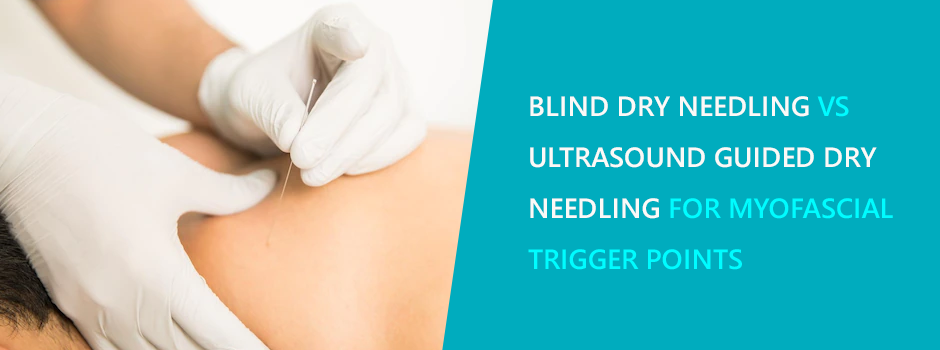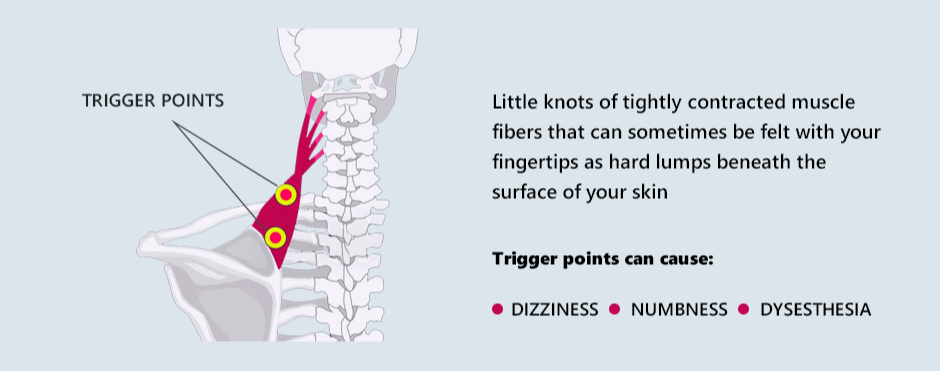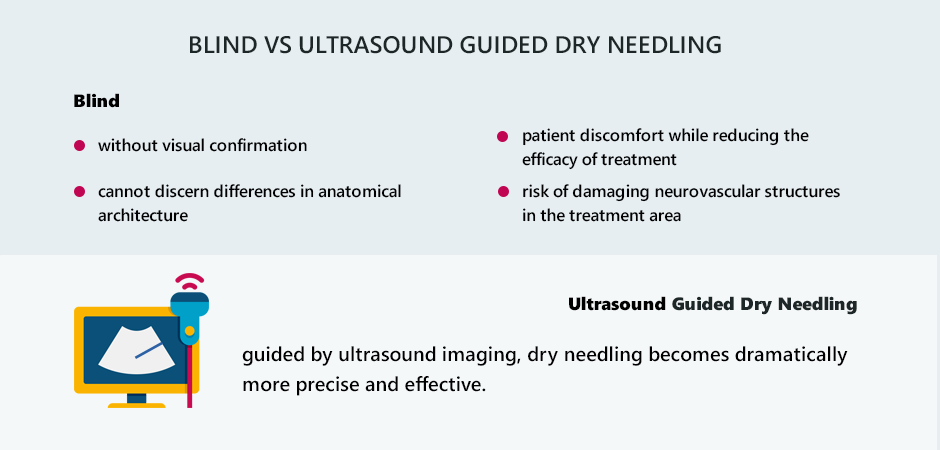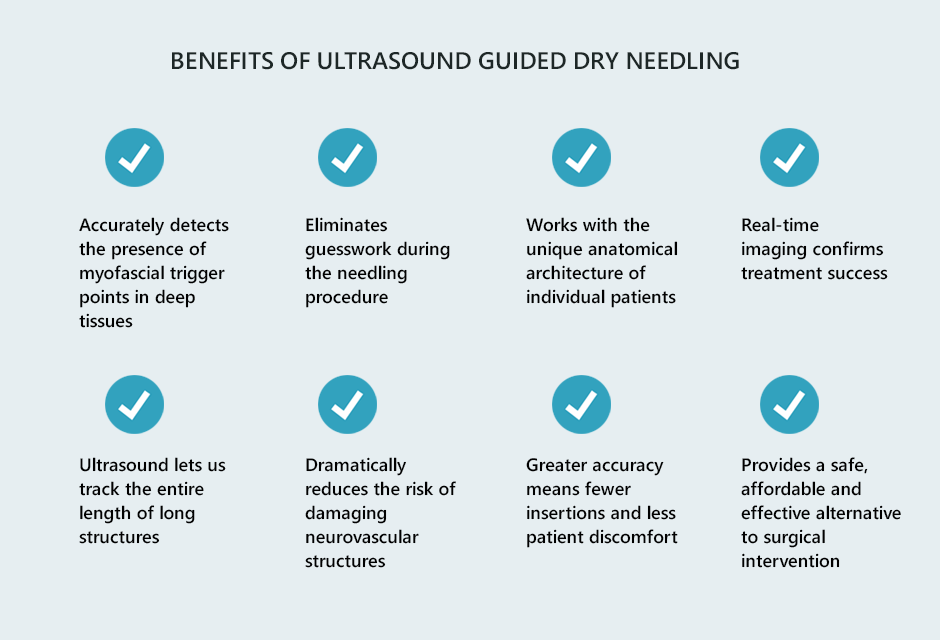
Whether you play sports, hit the gym or get knotted up while surfing the web, we all experience aches and pains in our muscles and joints from time to time. And while your body does a great job of bouncing back on its own, once in a while it needs a little nudge to recover from physical exertion.
Dry needling is a conservative therapeutic treatment that helps your muscles and joints recover from myofascial trigger points. Learn about dry needling, and how ultrasound guidance makes the procedure dramatically more accurate and effective .
Dry needling is a minimally invasive therapeutic procedure that targets myofascial trigger points, little knots of tightly contracted muscle fibers that can sometimes be felt with your fingertips as hard lumps beneath the surface of your skin. However, some trigger points occur deep within the muscles, in the fascia that encases muscles, or in connective tissue near the tendon-bone junction.
Trigger points arise when muscle fibers are challenged as they lengthen under a load, evoking a stretch reflex in the fibers. The stretch reflex is a protective mechanism that causes muscle fibers to contract tightly, to protect them from tearing. Even after the load is removed and the threat of tearing is averted, the fibers remain tightly contracted, sometimes causing pain and dysfunction in the muscles and joints.

Trigger points can be active, causing pain that radiates to other parts of the body, or latent, with only local sensitivity. In some cases, active trigger points can cause dizziness, numbness, and dysesthesia — an abnormal burning or prickling sensation.
Myofascial massage can sometimes be effective for coaxing superficial trigger points to relax, but when massage is not enough, or when trigger points are deeply embedded in the muscles or connective tissue, dry needling provides a safe and effective alternative.
During the dry needling procedure, the clinician inserts long thin non-medicated (dry) needles into the trigger point. This stimulates a twitch response in the affected fibers, causing them to immediately release their contraction and return to their normal relaxed state. As the trigger point relaxes, pain is eradicated.
While there are multiple scientific studies that support dry needling as a legitimate and effective therapeutic method, traditional dry needling has its limitations. While superficial trigger points can be easily palpated beneath the skin’s surface and are therefore easy to target, deep trigger points are not so easy to detect and treat.
Blind dry needling of deep tissues is somewhat of a fishing expedition, with multiple drawbacks:

Blind dry needling operates on the assumption that trigger points are present, without visual confirmation
Blind needling procedures cannot discern differences in anatomical architecture that deviate from the standard clinical model
Blind needling cannot guarantee accuracy, and multiple insertions may be necessary, increasing patient discomfort while reducing the efficacy of treatment
Blind needling procedures run the risk of damaging neurovascular structures in the treatment area
When guided by ultrasound imaging, dry needling becomes dramatically more precise and effective.
Ultrasound imaging is a game-changer when it comes to dry needling procedures. Benefits of ultrasound guided dry needling include:
Accurately detects the presence of myofascial trigger points in deep tissues
Eliminates guesswork during the needling procedure
Works with the unique anatomical architecture of individual patients
Real-time imaging confirms treatment success
Ultrasound lets us track the entire length of long structures, such as the sciatic nerve, to detect trigger points
Dramatically reduces the risk of damaging neurovascular structures during the needling procedure
Greater accuracy means fewer insertions and less patient discomfort
Provides a safe, affordable and effective alternative to surgical intervention

In one study on conservative vs surgical treatment of lateral epicondylitis — aka tennis elbow — outcomes after ultrasound guided dry needling were found to be as effective as open-release elbow surgery.
Another study found ultrasound guided dry needling to be highly effective for treating piriformis syndrome, a condition where the sciatic nerve becomes entrapped under the piriformis muscle, causing low back, buttock and leg pain. Trigger points are often present in piriformis syndrome.
There are numerous additional studies on ultrasound guided dry needling for a plethora of conditions, including low back pain, rotator cuff pain and dysfunction, knee pain, and various tendinopathies.
Dr. Kalika, clinical director of NYDNRehab, is a world-renowned expert on ultrasound guided dry needling, with multiple scientific publications on the topic to his credit. He uses the highest resolution ultrasound equipment currently available to detect myofascial trigger points and treat them with dry needling. If you are looking for safe and effective dry needling in NYC, NYDNRehab is Manhattan’s premier clinic of choice.
Resource
Bureau, Nathalie J., et al. “Treatment of chronic lateral epicondylosis: a randomized trial comparing the efficacy of ultrasound-guided tendon dry needling and open-release surgery.” European Radiology (2022): 1-11.
Fernandez-de-Las-Penas, Cesar, and Jo Nijs. “Trigger point dry needling for the treatment of myofascial pain syndrome: current perspectives within a pain neuroscience paradigm.” Journal of pain research 12 (2019): 1899.
Tabatabaiee, Abbas, et al. “Ultrasound‐guided dry needling decreases pain in patients with piriformis syndrome.” Muscle & nerve 60.5 (2019): 558-565.
Dr. Lev Kalika is a world-recognized expert in musculoskeletal medicine. with 20+ years of clinical experience in diagnostic musculoskeletal ultrasonography, rehabilitative sports medicine and conservative orthopedics. In addition to operating his clinical practice in Manhattan, he regularly publishes peer-reviewed research on ultrasound-guided therapies and procedures. He serves as a peer reviewer for Springer Nature.
Dr. Kalika is an esteemed member of multiple professional organizations, including: